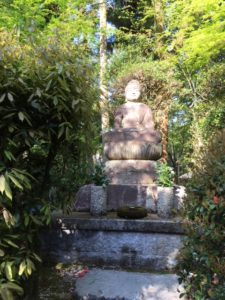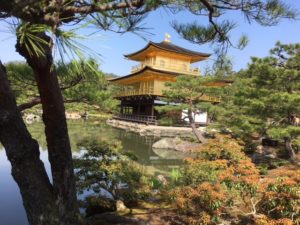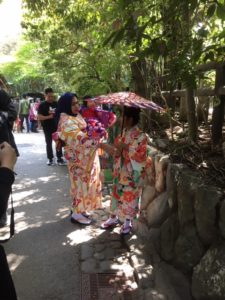
Buddha in the gardens at Ryoan-ji temple, Kyoto, Japan
Fifth in a Series
Kyoto has so many cultural and spiritual treasures that spending just a few days there can be an exercise in frustration.
But once you accept the fact that no matter how long you stay, you’ll probably only scratch the surface of what’s there, you can zone into a sort of Zen state and do and see just what you can. I’m sure most visitors, as we did, vow to return in the future to take in more. Still…
Even coming back
Many times will never be
Enough so chill out
Well, I never was very good at Haiku, but acceptance of the inevitable is key. Pick your battles and go forth and conquer what you can — even in the crush of visiting hordes.
I was impressed with the Zen-like demeanor of a German couple we met at our Airbnb who were still lounging around in their Japanese-style pajamas at 10:30 in the morning.
I mentioned that it was good to get to certain sites as soon as they opened in the morning to beat the crowds. But, perhaps mellowed by frequent visits to the local public baths, they were in no hurry.
“Maybe we’ll stay few extra days,” they allowed.
A More Manic Approach
I admit that I’m something of a manic sightseer (sometimes to the regret of my wife, Catharine), though it comes with the territory of being a travel writer. But Catharine is usually game, and so on our first morning in Kyoto we set out walking at 7 a.m. with an ambitious agenda ahead of us. Our first goal was to reach a notable Zen rock garden when it opened at 8 o’clock.
Arriving well before that — our Airbnb in northwest Kyoto, run by a delightful couple named Koji and Miho, was situated within easy walking distance — we were first in line and had the luxury of experiencing the serenity of the Ryoan-ji rock garden and its adjoining temple and flower gardens before the tour buses arrived.
The rock garden — of unknown origin but possibly dating back hundreds of years — consists of 15 rocks placed in a bed of perfectly raked sand. It’s the most famous such garden in Japan, possibly because no one knows exactly what it’s trying to say. It’s just there: spare, simple, enigmatic yet existing in perfect harmony with its surroundings. And that’s probably the point.
But unless you have the better part of a day to meditate on the meaning of rocks, it’s also a quick check mark on a Kyoto itinerary. Because when the tour buses start to disgorge their passengers, it’s time to skedaddle.
Kinkaku-ji — the Golden Pavilion

Kyoto’s Golden Pavilion is one of Japan’s best known sights.
Because we were on foot, we arrived at Kinkaku-ji, Japan’s most famous temple, five minutes after it opened at 9 a.m. It was already packed with sightseers, mostly Japanese, with a fair number of Europeans, Chinese, Americans, and more. (Cherry blossom season is understandably a popular time to travel in Japan.)
Shuffling along with the crowds, we were able to view the Golden Pavilion from front, back, and side, and — covered in gold leaf that glimmered in the sunshine in the center of a reflecting pool — it’s an impressive site, not to be missed.
But even out of season, I highly recommend arriving there on a weekday to get in line before it opens, or perhaps just before closing in late afternoon — not only to get the best unobstructed views, but, with luck, to avoid being skewered by hundreds of selfie sticks wielded by overzealous tourists of every nationality.
Geisha Central
Following breakfast, we arrived just in time to catch the end of a kimono-clad geisha parade at another temple.

Geisha or not?
April, when we were in Kyoto, is the month when geishas make their most public appearances, usually in the form of group dances. Otherwise, with a bit of good fortune, you might spot a geisha here or there around the city, but try to hold back on the selfies — the geishas aren’t there for our amusement, unless we’re willing to pay big yen for private company.
And, as I’m sure you know, they are not prostitutes but companions and entertainers.
There are said to be about 100 full-fledged geishas in Kyoto, and another hundred, aged 15 to 20, in training, making Kyoto Japan’s geisha central.
While it’s something of a dying art, that hasn’t stopped a sizable number of visitors from renting geisha-style kimonos by the day, complete with makeup and accessories, to make their own appearances around the city.
How do you spot the difference with an untrained eye? Unless the ladies are non-Japanese, it’s difficult, but it’s best to just assume they’re fake and enjoy the costumes. And if they eagerly pose for photos, including selfies to show your neighbors back home, they’re almost certainly just playing geisha for a day — but who’s to know?
Next Up: Bamboo, Baths, and a Breathtaking Temple Climb
Photos by Catharine Norton
For the first four posts in my Japan series, see:
Eight Great Reasons to Visit Japan
How to Prep for a Trip to Japan
Delving into Japanese Life in Tokyo
The Vibrant Allure of Tokyo Japan












2 Responses to Kyoto’s Wealth of Cultural Riches